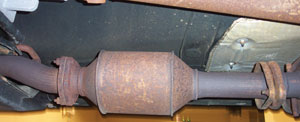Read up on essential products in our annual technical sales seminar section. We review 12 products you need to know better to move products.
Brakes
Fuel Pumps
Gaskets
Batteries
Wipers
Catalytic Converters
Shocks
Engine Management
Lighting
Belts and Hoses
Oxygen Sensors
Antifreeze
The catalytic converter is probably the most important emission control device on a vehicle because it cleans up the pollutants in the exhaust. Thanks to fuel injection, oxygen sensors in the exhaust manifolds and a feedback fuel control system, emissions are kept to a minimum. Even so, some pollution is still produced and must be eliminated by the converter.
 The OBD II system keeps a watchful eye on the operating efficiency of the catalyst inside the converter. On these vehicles, a “downstream” oxygen sensor is mounted aft of the converter in the exhaust system. The sensor generates a rich or lean signal that tells the engine computer how well the catalyst is functioning. If the converter is doing its job, there should be little switching activity to report.
The OBD II system keeps a watchful eye on the operating efficiency of the catalyst inside the converter. On these vehicles, a “downstream” oxygen sensor is mounted aft of the converter in the exhaust system. The sensor generates a rich or lean signal that tells the engine computer how well the catalyst is functioning. If the converter is doing its job, there should be little switching activity to report.
The engine computer compares the switching activity of the “upstream” O2 sensors in the exhaust manifold with that of the downstream O2 behind the converter to compute operating efficiency. If catalyst efficiency drops somewhere below 90 percent, it tells the computer that there’s a problem and sets a P0420 or P0430 catalyst code. The Check Engine light comes on, and the motorist now has to get a diagnosis to find out the nature of the problem.
In most cases, a code P0420 or P0430 usually means the catalyst has reached the end of the road. The vehicle won’t meet emissions or pass an emissions test unless the converter is replaced. But there may be more to it than simply replacing the old converter with a new one.
Converters can fail for a variety of reasons. Most late model OBD II converters should last upward of 150,000 miles under normal driving conditions. Eventually, the catalyst will be slowly poisoned by oil contamination as the engine’s oil consumption goes up with age and mileage.
However, other conditions may cause a converter to fail prematurely. These include ignition misfire, lean misfire and/or compression misfire that allow unburned fuel to enter the exhaust. When the unburned fuel hits the converter, the converter’s temperature soars. This may overheat the converter and damage the ceramic or metallic substrate inside the converter that supports the catalyst. A partial meltdown may create a restriction or blockage that increases exhaust backpressure. This, in turn, will hurt fuel economy and performance, and may even cause the engine to overheat.
The catalyst can also be fouled by coolant leaking into the combustion chamber past a bad head gasket, by using RTV sealer that contain high levels of silicone, or by using octane boosting fuel additives that contain lead.
Converters may also succumb to rust, corrosion and physical damage. The converter shell and heat shield are stainless steel, but do not last forever, especially in wet or corrosive environments where road splash and road salt are common. Cracks can develop in the converter mounting flanges or supports from vibration — especially if the exhaust system has some broken or missing hangars.
Theft is another problem. The catalyst contains a coating of platinum, palladium and rhodium, all of which are valuable metals worth $40 to $120 or more depending on the size of the converter and the current price of metals. Thieves also cause a lot of damage to the adjacent pipes when they hack out the converter, which adds to the repair expense.
All replacement converters come with a warranty (25,000 miles or two years minimum). But the warranty won’t do anyone much good if a converter failed due to an engine problem or contamination. The underlying condition needs to be diagnosed and repaired for the new converter to last.
Important Note: California has its own replacement rules and requirements for converters. Because of this, 49-state converters are NOT legal for use on California vehicles, whether the vehicle still resides in California or not. Refer to the underhood emissions decal to see if a vehicle is CA-certified or not.
Also, replacement converters for 1996 and newer vehicles must be OBD II certified. Converters for pre-OBD II vehicles cannot be installed on late model vehicles.
Some aftermarket replacement converters use catalysts that contain a special blend of metals or an extra thick layer of metals so the converter will continue to function efficiently in an older, high-mileage application. This can help keep the Check Engine light off so the vehicle will meet emissions for a longer period of time.
Once a converter has been replaced and the fault code(s) cleared, the vehicle will have to be driven for a period of time for the OBD II catalyst monitor to reset. The drive cycles for specific vehicles vary, but most require driving at various speeds plus a stretch of highway driving to reset the monitor. Once that has taken place, and no problems have been found, the vehicle should be ready to pass an emissions test.
If the Check Engine light comes back on and the same P0420 or P0430 code reappears, chances are the engine has one or more lazy upstream O2 sensors that need to be replaced.











